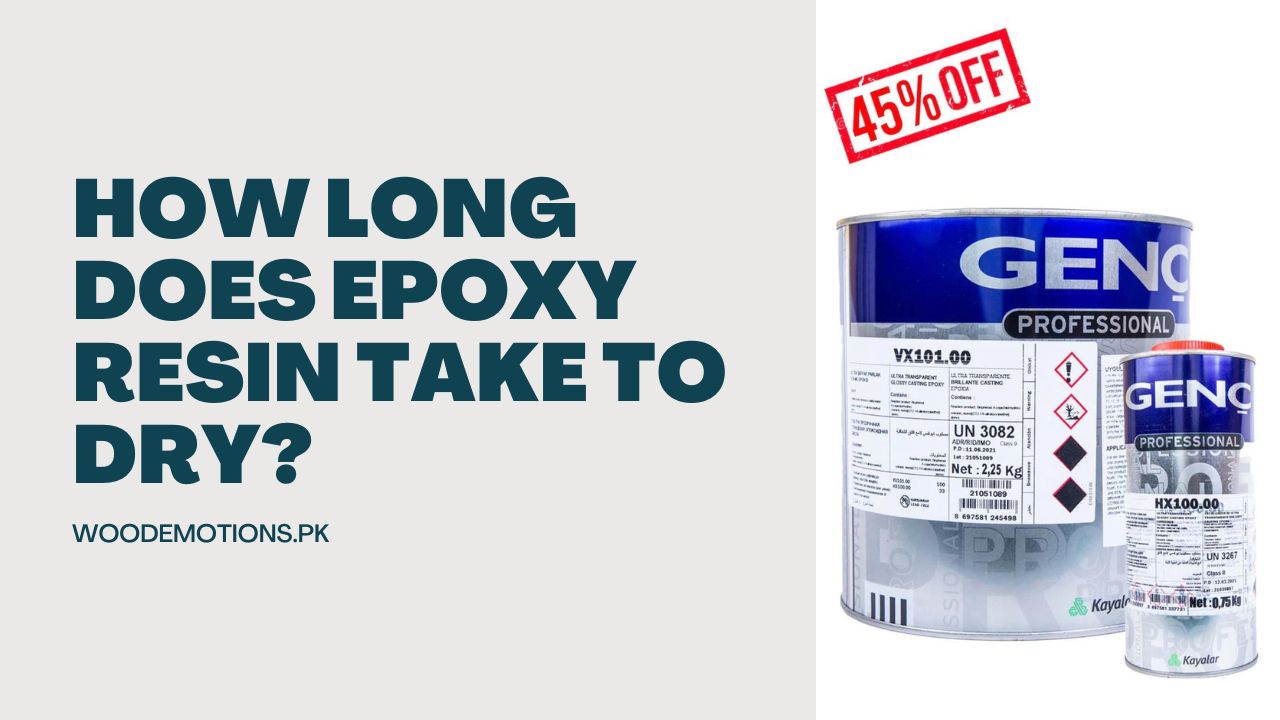Epoxy resin is a fantastic material known for its versatility and durability. Whether you're crafting stunning art pieces or sealing surfaces for industrial use, understanding its drying time is crucial.
For epoxy curing, expect a typical timeframe of around 7 days. However, your floor may be walkable after 12 hours and ready for light use within 24 hours.
In this article, we'll dive into the factors influencing epoxy resin drying time, typical drying durations, and essential tips for expediting the process.
You might wanna find out : How Epoxy flooring is done
How Does Epoxy Resin Work?

Epoxy resin is a versatile material that undergoes a chemical process to transform from a liquid to a solid state. Before delving into the details, it's worth noting that our epoxy collection page is the place to go if you need epoxy.
Discover a range of options that seamlessly blend durability with captivating aesthetic appeal. Let's delve into the scientific process behind it:
Chemical Reaction
Epoxy resin is a two-part system consisting of resin and hardener. When these two components are mixed, they undergo a polymerization chemical reaction. This reaction causes the molecules in the resin and hardener to link together, forming long chains known as polymers.
Cross-Linking
As polymerization progresses, the chains of molecules cross-link with each other. This cross-linking creates a three-dimensional network, like a spider web, where each strand is connected to multiple others. This network structure gives epoxy resin its strength and durability.
Hardening Process
During the chemical reaction, the mixture gradually changes from liquid to solid. This process is known as curing or hardening. As the resin and hardener react, they become increasingly viscous and solidify into a durable material.
Curing Time
The time it takes for epoxy resin to cure depends on various factors, including the specific formulation of the resin, ambient temperature, and humidity levels. Quick-cure epoxy resins may harden within a few hours, while standard formulations may take longer, typically ranging from 24 to 72 hours to fully cure.
Adding this RCU forum link for your convenience. I hope you find help from these discussions.
Factors Affecting Drying Time
The drying time of epoxy resin can vary depending on several factors. Understanding these factors is crucial for ensuring successful and timely curing. Let's explore them:
1. Temperature
Temperature plays a significant role in epoxy resin curing. Warmer temperatures generally accelerate the curing process, while cooler temperatures slow it down. Ideally, epoxy resin should be applied in an environment with a temperature range recommended by the manufacturer for optimal curing.
2. Humidity
Humidity levels can also affect epoxy resin drying time. High humidity can slow down the curing process, as moisture in the air interferes with the chemical reaction. Conversely, low humidity speeds up curing. Working in a well-ventilated area with controlled humidity levels is essential to achieve consistent results.
3. Thickness of the Coat
The thickness of the epoxy resin coat applied can influence drying time. Thicker coats take longer to cure than thinner ones because the heat generated during curing dissipates more slowly from thicker layers.
4. Type of Epoxy Resin
Different epoxy resins have different formulations, resulting in varying curing times. Quick-cure epoxy resins are designed to dry rapidly, making them suitable for projects requiring fast turnaround times. Standard epoxy resins may take longer to cure but offer other advantages, such as improved durability.
5. Mixing Ratio
The proper mixing ratio of epoxy resin and hardener is crucial for achieving the desired curing properties. Deviating from the recommended ratio can affect curing time and result in incomplete curing or other issues. Measuring and mixing the components accurately according to the manufacturer's instructions is essential.
6. Application Method
The method used to apply epoxy resin can impact drying time. Brushing or rolling epoxy resin onto surfaces typically results in thinner coats and faster drying times than pouring or spraying thicker coats. Proper application techniques, such as ensuring even coverage and avoiding over-application, can help optimize drying time.
7. Surface Preparation
Proper surface preparation is essential for promoting adhesion and achieving uniform epoxy resin curing. Surfaces should be clean, dry, and free of dust, grease, and moisture contaminants. Roughening the surface with sandpaper or primer can also improve adhesion and shorten drying time.
8. Ambient Conditions
Environmental factors such as air circulation and exposure to direct sunlight can affect epoxy resin drying time. Adequate ventilation helps facilitate the evaporation of solvents and moisture, speeding up the curing process.
Typical Drying Times

When working with epoxy resin, understanding drying times is essential for planning your projects effectively. Let's explore the typical drying times for both quick-cure and standard epoxy resins:
Quick-Cure Epoxy Resins
Quick-cure epoxy resins typically dry within a few hours, making them ideal for projects requiring fast turnaround times. However, curing time varies based on environmental conditions and application thickness.
Standard Epoxy Resins
Standard epoxy resins typically take 24 to 72 hours to dry completely. Temperature, humidity, and coat thickness should be considered when estimating drying times.
Here's another forum link I'm sharing with you. Many users have discussed the topic related to epoxy resin curing time here as well. My intention is solely to provide you with accurate information, so feel free to visit.
Tips for Faster Drying

When working with epoxy resin, achieving a faster drying time can be advantageous, especially for projects with tight deadlines. Here are some practical tips to speed up the drying process:
1. Use Heat Sources
Applying gentle heat to the epoxy resin can accelerate curing. You can use a heat gun, hairdryer, or heat lamp to provide controlled warmth to the resin surface. However, be cautious not to apply excessive heat, which can cause issues such as bubbling or cracking.
2. Proper Mixing and Application
Ensure thorough mixing of the epoxy resin and hardener to promote uniform curing. Follow the manufacturer's instructions carefully regarding mixing ratios and techniques. Apply the resin evenly in thin coats to facilitate faster drying.
3. Surface Preparation
Properly prepare the surface before applying epoxy resin by cleaning it thoroughly and removing contaminants or debris. Roughen the surface with sandpaper or use a primer to improve adhesion and promote faster curing.
4. Control Ambient Conditions
Work in a well-ventilated area with controlled temperature and humidity levels. Lower humidity and warmer temperatures generally result in faster curing times. Ensure adequate air circulation to facilitate the evaporation of solvents and moisture.
Common Mistakes to Avoid
Working with epoxy resin requires attention to detail to achieve the best results. Here are some common mistakes to avoid:
Incomplete Mixing
Failing to mix the resin and hardener thoroughly can result in uneven curing and weak bonds. Mix the components according to the manufacturer's instructions to promote proper curing.
Over-Application
Applying epoxy resin too thickly can extend drying time and increase the risk of uneven curing and surface imperfections. Follow the recommended application thickness to achieve the desired results.
Poor Surface Preparation
Neglecting correctly cleaning and preparing the surface before applying epoxy resin can lead to adhesion issues and compromised finish quality. Ensure the surface is clean, dry, and contaminant-free for optimal adhesion and curing.
Incorrect Temperature and Humidity
Working in extreme temperatures or high humidity can affect epoxy resin curing. To facilitate proper curing, ensure you work in a well-ventilated area with controlled temperature and humidity.
Rushing the Process
Trying to rush the curing process by applying excessive heat or handling the resin before it's fully cured can result in poor adhesion and finish quality. Allow sufficient time for the resin to cure completely before adding additional coats.
Using Old or Contaminated Materials
Expired or contaminated epoxy resin can affect curing and produce subpar results. Always use fresh materials and store them correctly according to the manufacturer's recommendations.
FAQs
1. Can I increase epoxy resin drying time by applying more heat?
While gentle heat can accelerate the curing process, excessive heat can cause issues such as bubbling or cracking, so it's essential to proceed cautiously.
2. Will epoxy resin cure if it's too cold?
Cold temperatures can significantly slow the curing process, so it's best to work in a controlled environment with moderate temperatures for optimal results.
3. Can I apply multiple coats of epoxy resin to speed up drying time?
While applying multiple thin coats can help reduce drying time compared to a single thick coat, it's essential to allow each layer to cure fully before applying the next to avoid issues with adhesion and finish quality.
4. What should I do if my epoxy resin doesn't cure properly?
Suppose you encounter issues with epoxy resin curing, such as tackiness or soft spots. In that case, it's essential to troubleshoot the potential causes, such as improper mixing, inadequate surface preparation, or environmental factors, and take appropriate corrective measures.
In Conclusion
While epoxy curing typically spans 7 days, your floor may become walkable within 12 hours and ready for light use after 24 hours. It's essential to consider these timelines for optimal results in your epoxy resin projects.







